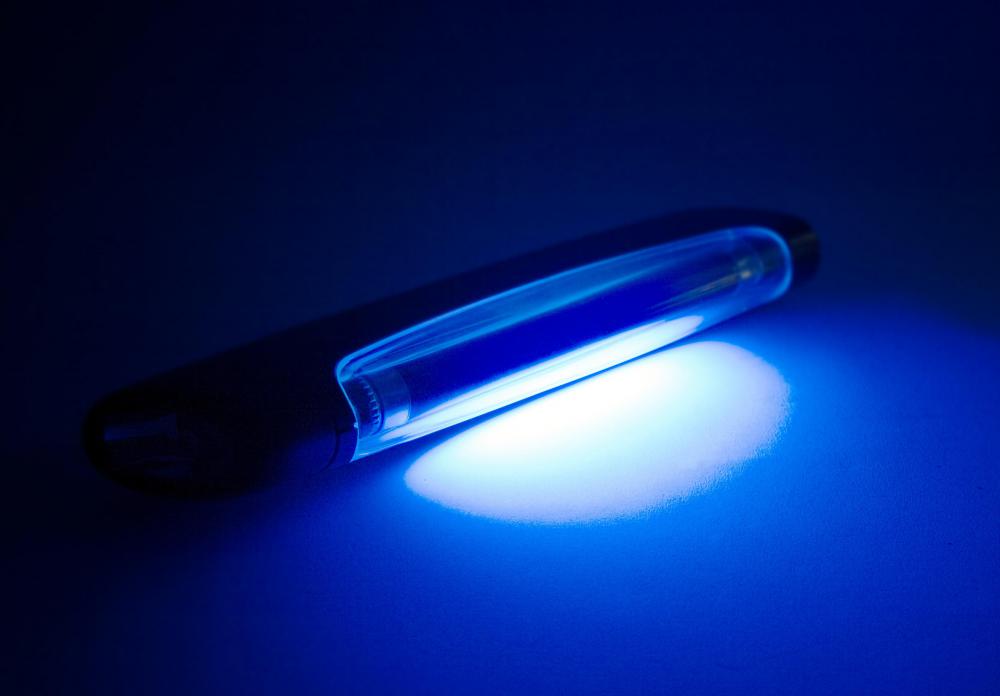At WiseGEEK, we're committed to delivering accurate, trustworthy information. Our expert-authored content is rigorously fact-checked and sourced from credible authorities. Discover how we uphold the highest standards in providing you with reliable knowledge.
What is a Fluorophore?
A fluorophore is the part of a molecule responsible for creating a fluorescent emission in the visible light spectrum. Known as chromophores, different wavelengths of light are absorbed by fluorophores, creating the light that is visible. This is essentially a region in which the orbits of two different molecules' electrons are located. The light impacts this region and excites the electrons to create the light. In the case of a fluorophore, this causes the stimulation of a less energetic wavelength.
Photons are absorbed by the fluorophore spectrum, but instead of creating a higher rate of excitement within the electron, it produces a lower rate. This causes the bright imagery usually associated with fluorescence. Essentially, the brighter the exposure light, the less fluorescence is seen. That is the reason that many fluorescent colors are seen best in light sources such as black lights.

Fluorophores can exist naturally or are introduced using artificial methods. Many fish and rocks maintain natural levels of this chromophore. However, it is most prevalent in the scientific community when used for research. It assists in the analysis of certain properties of materials, enabling researchers to identify reactions and changes in the fields of biochemistry and protein study. For example, the discipline of immunofluorescense uses the technique to help label antigens and antibodies at the subcellular level.

The most commonly used fluorophore in research is fluorescein isothiocyanate, a substance that can be chemically attached to molecules. This gives scientists a way to visualize the changes in non-fluorescent substances. Other examples include coumarin, cyanine and rhodamine. Certain substances using fluorescence can have adverse effects to the research, due to changes in the pH levels. As research progresses, new dyes are developed, each with different applications allowing for less intrusive changes to molecules.

Besides pure science, fluorophore modification has become a popular way to market products to consumers. One primary example of this is the GloFish™, genetically modified zebrafish available for purchase in red, green or orange fluorescent colors. In 1999, scientists from the National University of Singapore attempted to create a fish that could detect pollution. By merging the green fluorescent protein of a jellyfish with the zebrafish, the animal exhibited a bright fluorescence, especially under black lights. Soon, it was discovered that additional attributes from other sources, such as sea coral, could be used to create new colors, opening the way for living fluorescent animals to be sold as pets.
AS FEATURED ON:
AS FEATURED ON:













Discussion Comments
@croydon - There has been a lot of legal fuss over those fish. They are only sold in the United States and even some states there won't sell them, because of the genetically modified aspect.
And if you look at what happened when they showed that someone had created that fluorescent rabbit, there was a huge outcry about it.
One day people might start taking it for granted, but at the moment, there are (I think legitimate) fears that if people relax about one bit of genetic engineering, they will try to push through riskier and riskier changes.
It can be a slippery slope.
@KoiwiGal - Originally, I think scientists started playing around with that gene because it was easy to attach to other genes and then be able to tell whether they "took" to the animal.
So, if you introduced a gene for resistance to cancer, for example, and included the fluorophore "labeling" you'd be able to make sure the gene was properly accepted just by looking at the organism.
Whereas, it would be much more difficult to tell just by looking at a lab rat, whether they now had a gene that made them more resistant to cancer.
Of course, someone saw the commercial potential of the gene and made the GloFish.
I'm surprised they haven't got more things available, actually, like glow in the dark cactus or something, but I guess maybe the gene won't work with everything?
Unfortunately, GloFish aren't available where I live, because I'd love to have some.
I've also heard that an artist decided to have some fun with this kind of gene transfer and managed to order some glow in the dark rabbits.
It sounds like a hoax, but they basically did the same thing with the rabbits that was done with the fish and put the phosphorescence gene into them, so that their fur will glow in the dark.
I imagine that more and more pets will be available with this attribute. I think glow in the dark cats could be quite scary though.
It's already bad enough when their eyes glow at you from a fence. The whole cat might be a bit much!
Post your comments